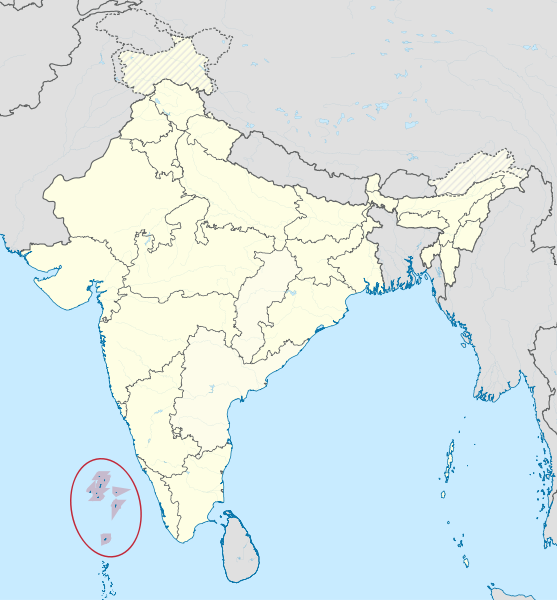 |
| Lakshadweep |
With the total land cover of 32 km², Lakshadweep is the smallest federal unit of India.
The Lakshadweep name comes from Lakhadwipa, which means "one hundred thousand islands" in Sanskrit.
Kavaratti serves as Capital for Lakshadweep.
The Island group is mentioned in Periplus of Erythraen Sea, Jataka tales, Stories of Ibn Battuta and accounts of Chola dynasty and other kingdoms.
Quick Facts
Established: 1 November 1956
Total area: 32 km²
Area Rank: 36
Official Languages: Malayalam, English
Other Languages: Mahi, Jeseri, Hindi
State Symbols of Lakshadweep
State Animal: Butterfly Fish
State Bird: Noddy Tern
State Tree: Bread Fruit
History
The earliest known mention of Lakshadweep comes from first-century Greek text Periplus of Erytharean Sea.
Also, the Island group is mentioned in the Sangam text as being controlled by Chera dynasty.
The oldest inhabited island in the group is Amini, Andrott, and Kavaratti.
It is found that Buddhism entered in the Island group around the 5th century, and Islam came to Lakshadweep around 661-62 AD. Today, 96 percent of the total population follows Islam, making it largest Muslim inhabited region by percentage.
During the late 11th century, Lakshadweep came under the rule of Cholas and later, Kingdom of Cannanore.
In the 16th century, Portuguese got control of Island group. Later, in the 17th century, the Island group came under the rule of Ali Rajah who received them as a gift from Kolathris (Kingdom of Cannonore).
These Islands are mentioned in great details in accounts of Ibn Battuta.
In 1787, the Aminidivi island group came under the rule of Tipu Sultan. The Island group came under the control of British after Third Anglo-Mysore War. British also took over rest of the islands in the Lakshadweep group from the Kingdom of Cannanore. In the 19th century, British grouped the Lakshadweep Islands to Madras Presidency.
On 1 November 1956, during the reorganization of Indian States, Lakshadweep was separated from Madras Presidency and established as a union territory.
Geography
Lakshadweep is an archipelago of 12 atolls, 3 reefs, 5 submerged banks and 39 islands and islets.
Lakshadweep forms an ecoregion with the Maldives and the Chagos.The region has more than 600 species of fishes, 78 species of Coral, 82 species of seaweeds, and 101 species of birds.
Lakshadweep archipelago is one of the four coral regions of India. Pitti or Pakshipitti, known for coral reefs, sea turtles, pelagic birds, and declared as a bird sanctuary.
Lakshadweep is also known for whales (Pygmy blue whale, Bryde's whale, Sperm whale, Orca, and Pilot whale) and dolphins.
On another side, Lakshadweep is not rich in terms of flora. There are no endemic flora species in the region.
According to 2011 census, Lakshadweep has the population of 64,429 with the population density of 2013 per km² and sex ratio of 946 females per 1000 males.
Religion
Islam is the largest following religion in the region with more than 96% of the total population following the religion.
Eid-ul-Fitr, Muharram, Eid-ul-Adha, Milad-un-Nabi (Moulood), and Rifai Ratheeb are the major occasion on the Island.
Languages
Malayalam, Jeseri, and Mahi are the major languages in the region.
Economy
Tourism, Fisheries, and Coconut industry are the major growth driver of Lakshadweep's economy. The economic inequality is low, so does poverty index.
Polity
Lakshadweep is governed by an Administrator appointed by the President of India. The Administrator also controls the Police in the region. The region comes under Kochi High Court jurisdiction and has one Lok Sabha seat.
